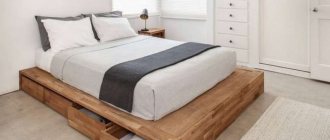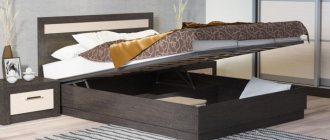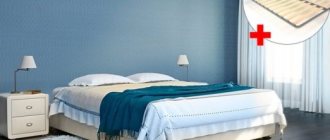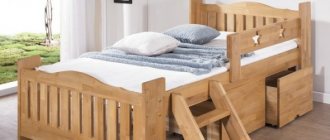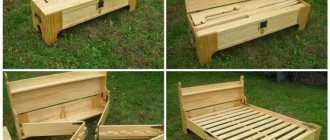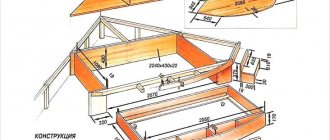Even those who have spared no expense in purchasing a bed are not immune to the appearance of squeaks - over time, the structure wears out naturally. However, if in most cases unpleasant sounds appear several years later, then why does a new bed purchased at a high price squeak and how to deal with it? Eliminating extraneous sounds in this case can only be effective if you find out the reason for their occurrence or take maximum precautions.
Beds 200×200
Why does a wooden structure produce an unpleasant sound?
Wooden beds are the oldest and most common type of bed for sleeping, and its creaking is a common drawback (how to properly assemble a wooden bed?). Typically the cause of squeaking is friction in the following places:
- frame corner connections;
- connecting the leg to the frame;
- joints of a lattice or lamella base;
- the place where the legs touch the floor.
If the bed is equipped with a lifting mechanism, squeaking may occur due to the friction of its parts against each other. Only spring mechanisms creak: gas lift mechanisms are designed in such a way that there is usually nothing to creak there. In spring devices, a squeak means that one or more springs have become deformed and need to be tightened or replaced.
Finally, sometimes the mattress itself can squeak. Usually this happens only with spring ones - stuffed ones made of coir, latex, and other materials do not have rubbing parts.
If a bed with a lifting mechanism creaks
In such models there are quite a lot of contacting elements
, so there may be more reasons for creaking than with ordinary furniture. Before you begin repairs, determine the source of the squeak. These can be ⦁ base boards or slats; ⦁ body; ⦁ armor holders; ⦁ lifting mechanism.
To find the source
squeaking ⦁ remove the mattress; ⦁ carefully check the integrity of the lamellas, the serviceability of the batten holders, the serviceability of the lifting mechanism; ⦁ if no problems are found, creaking may occur due to friction at the junctions - this can be eliminated by placing a gasket between the holder and the batten; ⦁ carefully check the reliability of the fasteners, tighten and lubricate them.
If a breakdown is detected ⦁ armor; ⦁ lamella holder; ⦁ gas lift - only replacing the faulty part will help.
How to determine the source of a squeak?
To understand where the bed creaks, you need to do the following:
- Remove pillows, blankets, and sheets from the bed.
- Remove the mattress. If it is on springs and creaks, it needs to be dealt with separately.
- Rock the bed first by both backs, listening to the sounds that arise.
- Shake the sidewalls, slats, and other frame elements.
- Take a closer look at how level and tightly the legs are on the floor. Sometimes squeaking occurs because the bed rocks on uneven floors and slides slightly over them.
- If the floor is plank or parquet, you should step forcefully several times on those elements that come into contact with the legs of the bed. Sometimes it happens that dry boards creak, but the bed itself is fine.
- If the source of the squeak is not detected, you need to lay the mattress on the floor, lie on it and turn around, simulating a restless sleep.
Advice
If it is possible to involve a second person in checking, then the easiest way to find the source of the creaking is to lie on the bed, turn around, and the assistant should at this time walk around the bed, listening and noting from which part the creaking is coming.
How can I fix it so that there is no sound from the base of the new stock?
Sometimes a furniture manufacturer is slapdash and uses low-quality materials - for example, unseasoned wood. Then, even in the store, the bed may be slightly deformed - not enough to detect it with the naked eye, but already starting to rub against the joints of the base.
You need to do this:
- Determine the source of the squeak.
- Disassemble the bed in the place where the creaking is coming from. If necessary, carry out complete disassembly.
- Thoroughly sand the joints with sandpaper or a sanding attachment on a drill.
- Apply a layer of lubricant. Soap, grease, paraffin, even children's plasticine are suitable. However, over time they wear out and will have to be lubricated again. It is best to apply a layer of silicone grease from the very beginning - one lasts much longer. When working with lubricant, be careful not to get it on the front sides of the bed or in those places where the base comes into contact with the mattress.
Attention
When reassembling, to be sure, you can degrease all joints and apply rubber glue. It will add additional strength to the base and will itself act as a lubricant.
How to eliminate a musical defect in the lifting mechanism?
If the bed lift mechanism squeaks, you first need to make sure that it is the problem. To do this, you need to raise the sleeping place and swing it up and down and from side to side several times. If there is no creaking, then you need to deal with the bed itself.
If the mechanism creaks, then you need to act like this:
- Check which part is creaking.
- Lubricate the part (for example, WD40 or similar).
Unfortunately, this is almost all that the owner can do on his own. Most gas lift mechanisms cannot be repaired, and it is unlikely that you will be able to tighten the spring yourself. If lubrication does not help, you will have to send the mechanism for repair or replace it with a new one.
How to get rid of the sound of a mattress?
A common cause of bed squeaking at night is the mattress. The reasons for this are:
- Incorrect position of the mattress on the base of the bed. If it does not fit tightly, then friction against the sides, backs or the bottom itself is possible. This can be corrected by rearranging the mattress or making rubber or thick fabric pads in the right places.
- Violations in the design of the mattress itself. In cheap models that use Bonnell spring blocks, creaking often occurs due to the friction of the springs against each other. Mattresses with independent springs (usually orthopedic) begin to creak when the structural elements wear out.
- Sometimes springless mattresses also creak. If they use polyurethane foam (PPU), then if the seal of the bubbles is broken, air can flow from one to another with a sound similar to creaking.
To get rid of squeaks associated with defects in the mattress design, you can try turning the mattress over. The load will fall on other springs or polyurethane foam bubbles, and the creaking will disappear for a while.
Important
Unfortunately, it is impossible to completely get rid of mattress squeaks at home. If the creaking has become completely unbearable, the mattress will have to be repaired. If a PU foam mattress begins to creak, there is nothing you can do at all - just buy a new one.
What can you do if the slats and frame sound?
For beds with slatted bases, a common cause of squeaking is wear and tear on the slats. In this case, both the crossbars themselves and the places where they are attached to the frame - the lath holders - can creak.
If upon inspection it turns out that the creaking comes from the lamellas, you should proceed as follows:
- Inspect and feel each of the planks. If cracks are found, damaged lamellas should be replaced.
- Check the lathe holders. If all the slats are intact, the fastening screws should be tightened. You need to act carefully: if you apply excessive force, the fasteners may crack.
- If the screws are tightened properly, but the slats creak, you need to press on each of the slats in turn. Having discovered a squeaky one, it is taken out of the fastenings and treated at the ends with silicone grease. If the size of the gaps allows, you can instead wrap the ends with a layer of felt or polyethylene foam. Then the bar is put in place - it will no longer creak.
- If there are no lath holders in the design, and the slats are placed directly on the screws, you should unscrew them, put a layer of insulating material (at least the same felt) under the slats, and then put them back on the screws, screwing in 1-2 additional ones next to each other to be sure.
How to eliminate frame and slats creaking
A frame with orthopedic slats takes on the entire load and redistributes it. That is why it wears out quickly and is often the cause of squeaking. Both the slats themselves and the places where they are fastened - the lath holders - can creak.
First you need to carefully inspect the slats for cracks, chips and deformation. Some of them may need to be replaced.
Prices for bed slats
Note! The slats are made from hardwood, usually birch. But the best wood for orthopedic slats is beech; it has high strength and, moreover, elasticity.
Lamels - what are they?
The cause of the squeak can also be broken lat holders. They are also subject to replacement.
If all the lath holders and lamellas are intact, you need to tighten the fastening screws on the lath holders. At the same time, avoid excessive force so as not to create internal stresses in the plastic, otherwise it will crack.
Pulling screws on the lath holders
Next, you should load each of the lamellas in turn, pressing firmly on it with your hand. Having identified the creaking slats, remove them from the fastenings, treat the ends of the slats with silicone grease, and if the gaps are large, wrap them in foamed polyethylene or felt. After this, put the slats in place. The creaking should stop.
What to do if the iron stock rattles a lot?
The reason for squeaking in a metal bed is the same as in a wooden bed - friction. However, rubbing metal parts make much more noise, so the creaking of metal furniture is much louder. You need to do this:
- Find the source of the squeak.
- Disassemble the creaking part of the bed and apply lubricant to the joints. As with wooden furniture, you need to make sure that drips do not end up on the outside and stain the mattress.
- If upon inspection large gaps are discovered, then gaskets made of thick fabric or rubber can be placed between the rubbing parts.
- Reassemble the bed, carefully checking how well the fasteners are tightened.
Advice
If the bed is made of iron, over time the metal may corrode, which also leads to squeaking. If the manufacturer is too lazy to carry out anti-corrosion treatment on the parts, the owner needs to do this by applying a layer of varnish to the parts (joints).
If a metal bed creaks
In this case, there can be only two reasons for the unpleasant sound: the fasteners have become loose or friction has arisen between the parts of the bed
.
To fix this, make sure that the mattress does not squeak, and then ⦁ carefully check the fastening points, ⦁ if necessary, clean the joints of debris; ⦁ tighten the fasteners; ⦁ use lubricant.
To prevent
squeaking appears ⦁ when installing the bed, install a gasket between the headboard and the bed; ⦁ do not forget to check the strength of the fasteners and lubricate them once every 3-6 months; ⦁ replace damaged fasteners with new ones in a timely manner.
A creaking bed is not a reason to buy new furniture. In most cases, simple repairs can completely solve the problem and allow you to use the product for a long time.
Ikea furniture - reasons, ways to eliminate squeaking
Furniture sold in the Ikea chain of stores is usually of high quality. However, even it can begin to creak. The reasons for this may be:
- Incorrect assembly. The main principle of Ikea is that they sell furniture disassembled, and the owner assembles the structure himself at home. If you have little experience in assembling furniture, you may under-fit parts that will begin to rub against each other during use.
- Manufacturing defects. Even this chain sells goods of poor quality, although this is rare.
- Sloppy fit. Often the slatted bottom creaks loudly when it comes into contact with the base.
You can solve these problems like this:
- Carefully check all joints. If there is any play, tighten the fasteners.
- If any of the parts turned out to be defective, contact the store with a complaint. If the warranty period has not expired, you are obliged to replace it with a working one or change the entire bed.
- If the bottom joints creak, you can apply lubricant or (which is better) make a gasket. You can use rubber, fabric or polyethylene foam.
Advice
Pipe insulation sold in hardware stores works well as a gasket.
If you choose the correct diameter, you can cut the insulation lengthwise and then put it on each edge of the lattice bottom. In this case, both a gasket and an additional spacer are obtained, which fixes the structure and removes any possible backlash.
In a separate article you can learn how to properly assemble an IKEA bed.
How to get rid of squeaks in an IKEA bed
IKEA is an excellent option for budget and not so budget furniture (in our case, the furniture was budget, because it was bought for a rented apartment). But what happens to her about 2 years later is very annoying, especially at night.
We purchased a regular bed. More precisely, its frame and slatted bottom, the mattress was purchased separately.
This is what she looks like.
Like any furniture from this store, the bed is easy to assemble; for it you will need a screwdriver, a hexagon and a pair of crazy hands.
But the problems begin a little later, when the slatted bottom begins to creak heart-rendingly when it comes into contact with the base of the bed. This is not very pleasant, I tell you. At night I even woke up from a creaking sound when I tried to roll over to the other side))
After quickly Googling all the possible ways to solve this problem, my husband and I went to a hardware store. Who would have thought that everything could be solved so simply, and most importantly, very budget-friendly.
So, in order to save yourself and your bed from unnecessary squeaks, all you need to do is buy pipe insulation.
You'll need to install insulation on both sides of each slatted bottom, so calculate the flow based on your bed's measurements. And then everything is simple and complicated at the same time. It is necessary to cut each insulation tube on one side to fit it onto the edge of the slatted bottom.
Thus, you will get that the slatted bottom is covered with a layer of insulation on all sides. This must be done from the outside and inside to avoid any contact between the bottom and base of the bed.
The insulation is available in different diameters and thicknesses; we chose the optimal one for our bed, taking into account that the slatted bottom would fit into the frame.
Difficulties arose only at the stage of laying the bottom into the frame, as it began to take off and jump out of the insulating pipe. That's why we worked with 4 hands. One holds the mattress, the second holds the slatted bottom, gradually moving towards the end of the bed. It took us all of 20-30 minutes, but we didn’t immediately figure out how to cope with the flying bottom))
Alexey, I generally agree.. Sawdust is expensive, and not everything can be bought from Ikea) They have cheap products, of course..
Preventive measures
Sometimes it's easier to prevent a squeak than to get rid of it. To avoid squeaking, you should do the following:
- Choose beds from quality materials. It is best to use those made from solid oak or beech - these species resist deformation and do not wear out for a long time.
- Monitor the condition of the fasteners. You should check how tightly the screws and nuts are tightened and whether the screws are seated tightly. If play is detected, tighten it until it stops.
- Check how level the bed is. If the floor is uneven or any of the legs are dangling in the air, you should put a small pad of appropriate thickness.
- To prevent the mattress from creaking, it must be turned over from time to time. In this case, the springs wear out more evenly and do not start squeaking longer.
- If possible, purchase mattresses with independent springs. There is practically nothing to creak in them until fatigue failure of the metal begins - and this takes years.
How to assemble a single, double, lift-up, children's, with an attic and playpen bed? Everything is quite simple if you follow the instructions. We talked about this in detail on the pages of our website. There is also interesting information on how to make a canopy over the bed, separate the bed from other areas in the room and connect two single beds into one large structure.
If a wooden bed creaks
The problem of squeaking occurs quite often when using wooden furniture. In most cases, this is due to loose fasteners
or breakage, so fasteners should be checked first.
⦁ Remove the mattress, if possible, it’s a good idea to remove the base as well. ⦁ Using a wrench, sequentially tighten the fastening bolts in the corners of the box, in the leg fastenings and other places. ⦁ Treat the fastening areas with machine oil, paraffin or silicone. ⦁ Check if the unpleasant sound has disappeared. If the problem is resolved, you can assemble the bed.
In addition to loose fasteners, the cause of a squeaking wooden bed can be ⦁ uneven floor - it’s worth checking its level; ⦁ a loose massive headboard - in this case, the headboard fastenings are checked, tightened, lubricated, and gaskets made of soft material - silicone, felt - are placed in the resulting gaps.
The problem of squeaking in a wooden bed can be prevented
. To do this ⦁ carefully check the furniture when purchasing, paying attention to the quality of solid wood or chipboard; ⦁ buy a mattress with an independent spring block - such models are more reliable and durable; ⦁ when installing a bed in a room, check the levelness of the floor using a building level; ⦁ create a support for a massive headboard on the wall; ⦁ periodically check the fasteners - tighten the bolts and lubricate the metal parts at least once every six months.


